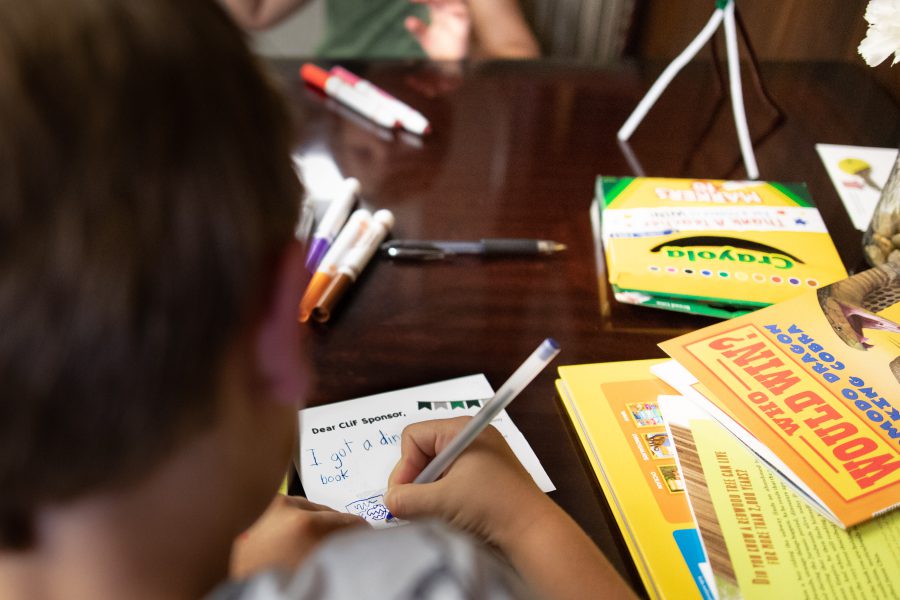
Literacy specialists want parents to prepare their children for school by sharing a love for writing, the attitude that writing is important, and the expectation that all children can become successful writers. How to do this? Encourage your child to write every day. Writing every day does not mean creating a completed piece every day. It simply means engagement in some sort of writing activity. This could be something continuous day after day like a developing story, but could also be something short like a journal entry, a letter to a relative, a poem, a one-sentence response to a question, or a list of words. Consistent writing for just 15 to 20 minutes a day will go a long, long way towards overall writing success.
Literacy specialists also want parents to know that good readers are often good writers. Successful readers become successful writers, and successful writers become successful readers. The connection is clear. Reading and writing are two of life’s greatest pleasures that go together, so the more reading and writing connections made, the better.
Start with the read aloud. Read to your child every day. Include fiction, nonfiction, newspapers, magazines, informational texts, letters, lists, and so on. Talk about what you read. Start with the favorite parts of the reading and progress to the author’s purpose. Progress further to the way the author introduced the story, and how the author showed something in an exciting way. The same applies for nonfiction texts, newspaper articles, or magazine articles.
Encourage your child to read to you, too. Not just books, but newspaper articles of interest, poems, letters, recipes, grocery lists, telephone messages, word problems from math books, and so on. Not only will your child learn that reading has a purpose, but that writing has a purpose, too.
Children need to hear, speak, and read as much as possible, so immerse your child with print. This increases knowledge and information later used in writing. Include poetry, stories, informational texts, biographies, science and history, and imaginative and factual books. Printed material provides more than just facts. It provides drama, problem solving, and precise language.
While a six-year-old may not use some of these benefits from reading right away in his writing, the repeated exposure will have some impact later on. Children learn to write by first hearing similar writing, then speaking or using that writing, and then writing something similar on their own. It’s like learning a new word. Children first hear the word, then use the word, and then recognize the word in print.
The importance of the reading and writing connection cannot be overstated. While it is true that children learn to write by writing, it is also true that children learn to write by reading. Want to become a poet? Read more poetry. Want to become a journalist? Read more articles. What’s most important is that all children need to become better writers to become more successful in school. This is true in grade one all the way through high school, college, and beyond.
Where to start? Jim Trelease, author of The Read Aloud Handbook, suggests leaving books, paper, and pencils scattered around the house. This means on the living room couch, the kitchen counter, and a bedside table, for examples. When books, paper, and pencils are within eyesight, they are more likely to be picked up and used. Keep them within arm’s reach.
Start with writing sessions as soon as possible. Try to set aside the same time every day. This turns the writing session into a routine. Not only will your child look forward to this time of day, and look forward to the extra attention, but this habit will ensure continued follow-through. Consider linking to homework routines, and then completing after the homework is finished. Or consider linking to the daily read aloud or independent reading time, and then completing after the reading time. You can start with as little as 5 to 10 minutes a day and then increase to 10 to 15 minutes a day, or 15 to 20 minutes a day, as appropriate.
Are you a writer? Do you write throughout the day? Do you write at work? Share what you do with your child, share experiences of writing in the real world, and show that writing has purpose. Show that you write shopping lists, send birthday or get well cards, or write memos to others. Add other types of writing such as text messages, e-mails, letters, and lists. When your child sees that writing is a part of your life, she will see that writing could and should be a part of her life, too.
It should be noted that there is no need to compete with electronics such as television, computers, or games. Consider turning the electronics off and leaving the room to another setting. This simple act will put it out of mind. Offer your child a chance to watch or play something entertaining, and then afterwards, start the writing time. Your child will most likely be more ready and receptive to the writing. Include writing prompts about whatever your child enjoys watching or playing. The topical interest may be sparked.
Finally, if your child is tired, or seems not to be interested in the writing at the time, or somehow seems frustrated, it is best to end the writing session and try again another time when your child is not so tired, disinterested, or frustrated. Keeping the writing sessions something your child looks forward to is most important. Continue the writing sessions for as long as possible. Even successful writers leading hectic lives will often enjoy their writing times.
Literacy specialists also want parents to know that practice is vital. Writing is a skill similar to other skills that require training. Readers become better readers by practice. Children become better at playing the piano by practice. Teens become better soccer players by practice. Likewise, writers become better writers by practice, too. Simply put, writers who spend 15 to 20 minutes a day engaged in worthwhile writing activities are more likely to become successful writers than those who do not write every day.
Is there a writing crisis? Some people think so. Proper writing is difficult to teach. It often doesn’t get the attention it deserves. However, there needn’t be a crisis in your household. Practice writing 15 to 20 minutes a day, and watch your child grow as a writer.
Should you help your child with writing? Yes. That is, if you want your child to do well in school, enjoy self-expression, and become more self-reliant. Do you need to teach writing? No. Instead, think of yourself as a coach, a cheerleader, and a supporter. When to begin? Begin right now, this minute, if you can. Start by working on a positive attitude. If you can send your child to school with the attitude that writing is important, then your child’s teacher can take over. Praise the effort more than the product. Celebrate attempts.
Producing a successful and competent writer will take some time. Just like your child didn’t learn to walk all at once, but walked, wobbled, and fell, learning to write will take time and practice to become proficient. Provide times for writing every day, and you will see progress. Your child will develop over the years. Look for that growth and development.
Children want to write. They want to write the first day they attend school. Donald Graves, Educational Researcher, states that “When children come to school about ninety percent believe they can write. Only fifteen percent believe they can read.” Children and teens are on the right track. They are writing a lot, and are writing stories, persuasive papers, letters, PowerPoint presentations, Prezi presentations, and websites. In addition, they are writing texts and e-mails, as well as other social media. This is writing to them. It’s sharing thoughts through written communication.
Literacy specialists around the world are unified on this message: one of the best gifts parents can give their children is the gift of writing. This begins with parents writing with their children and continues with children writing on their own. Those children who have been writing regularly since their earlier years often do better in writing and school than their peers who haven’t been practicing. This advantage continues through the middle school years, the high school years, and beyond. Those children who have been writing and practicing often become successful writers who continue to be successful throughout their lives.
20 Writing Session Reminders
Read to your children every day.
Immerse your child with print.
Write with your child every day.
Write what you and your child enjoy writing about.
Invite your child to read the writing to you.
Discontinue writing that is not being enjoyed.
Children learn by imitation. You are a role model.
Share your writing with your child.
Leave books, paper, and pencils scattered around the home.
Stop and discuss new vocabulary words.
Allow for discussion before, during, and after writing.
Ask open-ended questions such as “why” and “how.”
Try to connect or relate the writing to life.
Talk about what you are doing and why.
Stop when frustration hits.
Keep sessions something your child looks forward to.
Offer praise often.
Celebrate attempts.
Smile a lot.
Laugh as much as possible.
Bruce Johnson is a former educator, retired reading specialist in Merrimack Valley School District in New Hampshire, and author of Helping Your Child Become Successful in School: A Guide for Parents. Learn more at www.guidesforparents.wordpress.com.




This is such a great post because the majority of information regarding childhood literacy focuses solely on the reading aspect. Writing is very rarely mentioned, but it is so important as well! While reading helps kids gain the language, writing encourages them to comprehend and practice it. Great post!